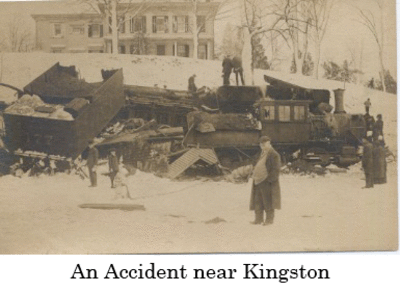A Fascination with Disaster in Ulster County
- by Bruce E. McKinney

Ulster County Railroad Disasters
Read some history books and you’ll notice they tend to focus on triumphs, jumping from one signal event to the next, illuminating reconciliation following the Civil War rather than wartime casualties; or development of the railroads rather than their relentless bankruptcies. Every triumph has its side dark and although not often emphasized such details occasionally still see the light of day. The caliginous side of industrialization is part of this forgotten story, was in its time well documented in newspapers, magazines and photographs, then repressed and since in the main ignored. It turns out that in war we expect and honor casualties, in peace casualties are simply the price of progress and we forget them soon enough.
Today almost everything is regulated. If you want to sell milk it has to be tested. If you want to introduce a drug it will be years before approval is granted. If you design a car figure three to five years for certification. Nothing it seems is easy today but it once was. In the later 19th into the early 20th century you needed only capital and ideas. Manufacturer’s claims were as strong as the paper they were written on and buyers and customers the guinea pigs to confirm or disprove them. Along the way some few became bacon.
The development of steamboats and railroads are a case in point. Their speed, comfort and majesty have come down to us as talisman of the emerging industrial era but they also crashed, burned and blew up. We know this because their destructions, in the era before photography, were chronicled in print media and occasionally books. One of the famous early disaster editions was S. A. Howland’s 1840 “Steamboat disasters and railroad accidents in the United States” … later amended in 1846 to include further accounts of recent shipwrecks, fires at sea and other mayhem. Photography would add enticing detail but wait a half-century before becoming the norm.
In the intervening decades Currier & Ives would sell prints of the great disasters, recording the human price paid as industry and commerce bounded on, at every step a good twenty years ahead of safety regulations. Enterprise, it turned out, developed quickly while law evolved slowly. “Get it done and see what happens. The techniques and equipment may be untested but we’ll know soon enough.” Come the turn of the 20th century, inexpensive photography and higher speed film made it possible to record the outcomes of an economy that favored lax standards in an era of progress at any cost. In 1906 in Upton Lewis’s account of food packing, The Jungle, brought conflicts in the meatpacking field into view. At the local level these conflicts played themselves out in other ways. Safety issues, long ignored, in places like Rondout and in Ulster County became visible.
In 1992 I bought a copy of Howland’s Disasters to read, never expecting that a national subject could become a local collection. The book itself mentioned next to nothing about the Hudson Valley but the idea took hold that such events had occurred everywhere with depressing regularity. Ten years ago I began to notice random appearances of Ulster County and nearby disasters that are the basis for this article.